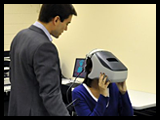
Kevin Coppersmith of Sync Think, Inc., tests a subject at the U.S. Army Research Institute of Environmental Medicine at Natick Soldier Systems Center using a portable eye-tracking device his company developed. The device might one day be used in the field to check Soldiers for possible traumatic brain injuries.
Photo Credit: Bob Reinert, USAG-Natick Public Affairs
|
NATICK, Mass. (March 1, 2012) -- Long hailed as windows to the soul, the eyes also might provide insight for researchers at the U.S. Army Research Institute of Environmental Medicine, or USARIEM, who are evaluating and working to improve methods for detecting traumatic brain injuries, or TBI, in Soldiers while they are still deployed.
"The ultimate goal is to provide the most accurate and efficient tools and techniques for determining Soldier performance and readiness," said Dr. Kristin Heaton, a neuropsychologist at USARIEM, "and bringing these tools as close to where the Soldier is working and performing his or her duties as we possibly can.""
The EYE-Tracking Rapid Attention Computation, or EYE-TRAC, device being developed by Sync Think, Inc., of Boston, could provide a new tool in that quest. The portable device, which includes hooded goggles worn by the patient and a hand-held peripheral that displays results, tracks eye movements with two high-speed cameras as the patient follows a moving target on a screen.
"It's a relatively simple test, but the device uses complex algorithms to quantify how well a subject can follow, and synchronize with, the target," said Kevin Coppersmith, Sync Think CEO. "We're measuring attention performance, a subject's focus. We believe eye-movement control provides a window to the brain and can be a reliable indicator of brain health."
According to Coppersmith, desktop eye-tracking devices have been available for a decade, but EYE-TRAC would bring the technology closer to deployed Soldiers who suffer blast injuries.
"In order to make the device portable, ruggedized and self-contained, we had to build the end-to-end system from scratch," Coppersmith said. "We found that there is no head-mounted eye-tracking technology with the performance specifications to do clinical-grade testing."
USARIEM has teamed with Dr. Jamshid Ghajar of the Brain Trauma Foundation to do this research, which includes funding by the Department of Defense. Three hundred-fifty Soldiers will be studied at USARIEM, located at Natick Soldier Systems Center.
"By evaluating a person's tracking performance, we can make inferences about their attention system function," Coppersmith said. "Attention is one of the cognitive processes that [are] often affected by brain injury or illness. It can be a fairly sensitive, but not necessarily specific, indicator of brain injury."
Coppersmith said that eye movements are captured by EYE-TRAC in a 30-second test, and then graded and analyzed.
"The results presented on the hand-held are easy to read and understand, and the subject's scores are compared to normative values and also to baseline performance," Coppersmith said. "Significant deviations from either could potentially indicate further follow-up by a medical professional."
"It's a combat-readiness tool," ," Coppersmith explained. "We're careful not to use the term 'diagnostic,' because a diagnosis tends to include other testing and patient history, but we have found significant differences in eye-movement behavior in those with injury relative to those who are healthy."
How big a role EYE-TRAC will play in the future of TBI detection in Soldiers remains to be seen.
"This is one tool out of many that we're evaluating," Heaton said. "It's part of an ongoing effort, really, to provide accurate, efficient assessment tools and techniques for field use. The closer that we can get to where Soldiers are and where they may be working and injured, the more quickly we're able to get them appropriate treatment after injury."
Yet, nothing will replace people in the equation, Heaton added.
"Tools such as EYE-TRAC," said Heaton, "may provide valuable information about brain function that, when used together with other tests and clinical observations, could facilitate return to duty decision making and treatment planning."
Learn more at Army.mil
|